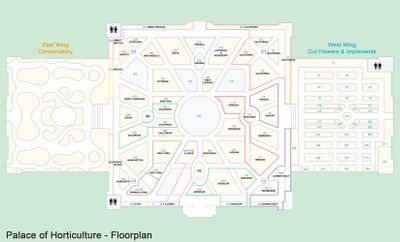Palace of Horticulture: Difference between revisions
No edit summary |
No edit summary |
||
| Line 7: | Line 7: | ||
| caption = Palace of Horticulture | | caption = Palace of Horticulture | ||
| alternate_name = | | alternate_name = | ||
| location = [[ | | location = [[Agriculture Area]] | ||
| no_buildings = 1 | | no_buildings = 1 | ||
| construction_cost= $227,338 (${{Format price|{{Inflation|US|227,338|1904}}}} in {{Inflation/year|US}}) | | construction_cost= $227,338 (${{Format price|{{Inflation|US|227,338|1904}}}} in {{Inflation/year|US}}) | ||
Revision as of 06:34, 4 December 2022
| File:Palace of Horticulture.jpg | |
| Location | Agriculture Area |
|---|---|
| No. of Buildings | 1 |
| Construction | |
| Construction Cost | $227,338 ($6.86 million in 2021) |
| Architecture | |
| Architect | E. L. Masqueray |
 | |
The Palace of Horticulture, the least ornately built palace, occupied 7.1 acres on Agriculture Hill, 250 feet south of the Palace of Agriculture.
Description
Architect E. L. Masqueray used the shape of the Greek cross adding a 400 sq ft. center pavilion, and two sunken wings (204 by 200 feet) to complete the design.
The center pavilion contained the table exhibits of the pomological (fruit) department, and here were shown fresh fruits and berries of the season in competition.
The east wing of the building was a conservatory and furnished exhibit quarters for specimens of plants and for forcing (the process of speeding up blooming or fruit production by changing climate, food, etc.).
The western wing opened up to a 76 foot rotunda with an electric water fountain. This wing showcased displays of cut flowers.
Underneath the structures, a huge basement was used to provide cold storage for the fresh fruits and produce.
The space between the Horticultural and Agriculture Palaces, and on the grounds surrounding them both, were ornamental rose gardens in which exhibiting florists and nurserymen maintained their respective beds.
Over 100,000 8 1/4 inch China plates created by the Ohio China Company were used to display the exhibitors and contestant's wares.
October 4th was designated Apple Day, every fairgoer to enter the palace received a free apple.
Notable Exhibits
Inside the palace, were vast displays of the different states and territories covering their spaces allowed with wares, produce and a seemingly unlimited variety of fruits grown in every temperate, tropical and semi-tropical climates. The largest displays were by Missouri and California. There were many contests and tasting events or all kinds, including cut flowers.
As with the Palace of Agriculture, the massive Horticulture structure's exhibitors had a flair for creating displays to lure the eye or raise the eyebrow. There were potatoes the size of watermelons and massive pumpkins.
- Nebraska exhibit included apples with names and phrases grown into the peel.
- California exhibit included an enormous elephant and a replica of the of the state capitol made out of almonds.
- Mississippi exhibit included A horse sculpture made entirely out of pecans.
